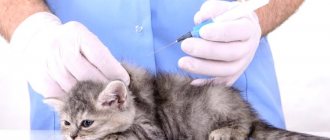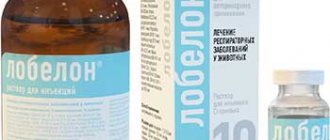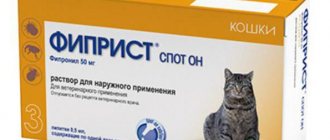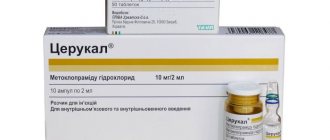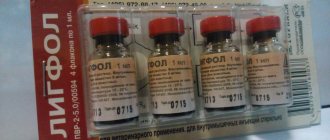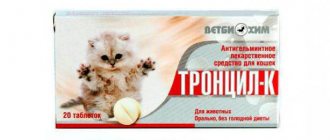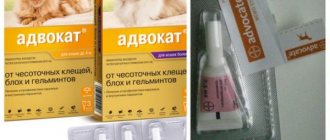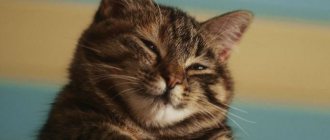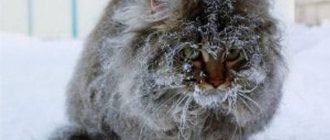Artroglycan for cats: when prescribed, composition and instructions
Animals are like people: with age, they are also overcome by various ailments, your pets become less active and playful, they try to rest more often, their gait may change... This happens because over time, many pets begin to have problems with their joints, spine, limbs. But this can be avoided: now there are many drugs that can restore a cat to its former lightness, jumping ability and playfulness. These drugs are chondroprotectors. And one of these is Artroglycan, which has good reviews among cat lovers.
Artroglycan is a veterinary drug that is used when it is necessary to strengthen and restore connective tissues and cartilaginous tissues. The drug is prescribed not only for the prevention of problems with the musculoskeletal system in animals, but also for the treatment of existing diseases.
Instructions for the medicine
Artroglycan is available in the form of light gray tablets.
Artroglycan - composition:
- Chondroitin sulfate (0.2 g) - helps reduce calcium excretion, slows down the process of destruction of bone tissue;
- Glucosamine hydrochloride (0.1 g) - necessary for the production of joint fluid;
- Calcium gluconate (0.1 g) - stabilizes metabolic processes in tissues;
- Selenomethionine (50 mcg) is a trace element that improves immunity and has a positive effect on the heart;
- Vitamin E (0.02 g) - antioxidant, immunostimulant, promotes tissue regeneration, etc.
The substances contained in the drug have a targeted effect on cartilage tissue, relieve inflammation, have an analgesic effect, improve the reproduction of joint fluid, and have a positive effect on the functioning of the animal’s heart and liver.
Artroglycan for dogs instructions for use
According to the instructions, artroglycan for dogs is mixed with food and taken for 3-4 weeks according to the following regimen:
- For dogs whose weight is less than 40 kg, the instructions require taking 1 tablet for every 10 kg of weight, 2 times a day.
- Dogs weighing more than 40 kg are recommended to take 4 tablets 2 times a day.
Artroglycan is a complex drug, so it is suitable for most pets.
The basic rule is one tablet for every ten kilograms of body weight. It should be given twice a day. Heavy pets - more than forty kilograms - are prescribed four tablets twice a day. The effect does not occur immediately; positive changes are possible earlier than fifteen to twenty days after the start of treatment.
The course of treatment and dosage are selected by the doctor taking into account the specific breed
Dogs at risk are recommended to take the drug prophylactically twice a year for three to four weeks. The dosage will be half the therapeutic dose. Such animals, as well as inactive and overweight pets, are given prophylaxis from the age of three. Representatives of other breeds can be given the product after six years.
The drug will perfectly help puppies during the period of teeth growth, when the body needs a lot of calcium. Artroglycan is its source. Thanks to its anti-inflammatory properties, the drug will help avoid gum problems. Like most vitamin supplements, this product is intended for oral use. It is best to mix the tablet with food.
If a cat has diseases of the spine and joints, many veterinarians prescribe Artroglycan for treatment. This product inspires confidence among veterinarians and praise from breeders. The dosage in each specific case is prescribed strictly individually. In some cases, the drug should be given together with specially developed feed.
For prevention, Artroglycan is used only in the autumn-spring period. Thanks to this, you can support the animal’s weak immunity. It is very important to strictly follow the instructions for the drug. It contains all the necessary instructions regarding daily doses calculated for cats. The medicine should be purchased for long-term use.
We suggest you read: Why does a cat yell (at night, at each other, in the spring...)
Artroglycan is successfully used to eliminate pathologies of the musculoskeletal system not only in dogs and cats, but also in rodents - rats, hamsters, chinchillas, guinea pigs. For each, a single dosage is specifically provided - half a tablet twice a day. The veterinarian who prescribes treatment may adjust the dose based on the severity of the disease. For prevention, the drug is given to rodents in autumn and winter.
The drug can be purchased at any veterinary pharmacy; it should be stored in a dark place inaccessible to children at an air temperature of zero to twenty-five degrees. Shelf life from the date of manufacture is twenty-four months.
Indications for use of the drug Artroglycan
- Degenerative diseases of the joints and spine;
- Primary arthrosis;
- Intervertebral osteochondrosis;
- Osteoarthritis;
- Osteoarthritis;
- Spondylosis;
- Osteoporosis;
- Joint dysplasia.
Degenerative diseases of the joints and spine
Although such diseases more often plague dogs than cats, it cannot be said that they do not occur at all in cats. Adult cats often have joint problems. In addition to age, problems with joints can also begin against the background of infectious diseases, injuries, and often problems with joints are the “calling card” of a certain breed:
- Abyssinian and Devon Rex cats are prone to sprains;
- Maine Coons, Persians and Siamese are prone to such pathologies as hip dysplasia;
- Scottish Folds are prone to severe arthritis, etc.
Symptoms of the development of degenerative changes in a cat’s body:
- Animals begin to limp;
- Reluctance to jump on sofas, beds, or climb stairs;
- After the cat rests, it is difficult to get up, the pet’s gait becomes difficult, it is clear that it hurts to walk;
- The cat often licks the joints when he “washes” with his tongue;
- The animal becomes irritable: when trying to pick it up or even just pet it, the pet begins to rumble, hiss, or even try to bite.
Primary arthrosis, intervertebral osteochondrosis
Primary arthrosis is a chronic disease that is non-inflammatory in nature. Most often it affects older animals and representatives of large breeds. Associated with the process of natural aging of the animal’s body:
- Metabolic processes slow down (blood exchange in bone tissue becomes longer);
- The cartilaginous structure of the joints wears out and wears out;
- The vitamin and mineral balance is disturbed.
With intervertebral osteochondrosis, the mobility of the spine decreases. Excessive load on the spine (for example, overweight in a pet) or injury can cause the intervertebral disc to shift and begin to compress the nerve roots that extend from the spinal cord, and sometimes the spinal cord itself. Neglect of treatment can lead to complete paralysis of the animal's hind limbs. The development of osteochondrosis largely depends on the diet of your pet: an excess of calcium in the diet can lead to its excess beginning to be deposited on the joints.
Osteoarthritis and osteoarthritis
Osteoarthritis is a form of chronic joint inflammation when joint mobility is lost (usually the shoulder and elbow joints in older animals). It can also be caused by injuries: dislocations, fractures in which the joints were affected. Osteoarthritis is degenerative changes in joint tissue.
Reasons for development:
- Congenital disorders (for example, this disease can often be observed in Scottish cats);
- Injuries;
- Consequences of surgical interventions (for example, when removing the claws of cats - this operation is prohibited in many countries of the world. It leads to disruption of absolutely all functions of the musculoskeletal system, since the claws are removed along with the upper phalanx of the finger, cats suffer from chronic pain syndrome. Or after tendoectotomy - cutting the tendon of the finger, as a result of which the cat cannot move its claws. In animals that have undergone these operations, the risk of developing arthrosis is enormous);
- Age-related changes;
- Load on the joints (excess weight of the pet);
- Metabolic disorders.
Spondylosis and osteoporosis, joint dysplasia
Spondylosis is a pathology of the spine that affects older cats. With spondylosis, processes (osteophytes - bone spurs) form between the vertebrae, which begin to put pressure on the bone marrow. Most often, such lesions occur in the lumbar and sacrum areas.
Osteoporosis is a decrease in bone mass in cats. Causes:
- Lack of calcium (more common in those animals whose main food is meat);
- Parathyroid tumor (benign or malignant);
- Age;
- Chronic kidney and gastrointestinal diseases.
Joint dysplasia is a complex pathology in which the articular head and socket do not coincide. Reasons include heredity and rapid growth of the animal (large breed cats).
Symptoms:
- Weakness of limbs damaged by dysplasia;
- Limited movement;
- Wobbling gait;
- Thinness of limbs;
- Painful sensations.
Drug treatment
Treatment of arthritis in sick cats should be comprehensive and include several areas. The main goal is to stabilize the condition and improve the quality of life of patients. The disease, unfortunately, has no cure, but with good supportive therapy and proper care, remissions will be quite long, and motor activity will be restored almost completely. The following types of therapy are used:
- surgical intervention;
- drug therapy;
- special care;
- rehabilitation measures to maintain a stable condition of the joints;
- therapeutic nutrition and weight correction;
- physiotherapy.
Special care
It consists of creating comfortable living conditions that make life easier and reduce joint pain:
- first of all, this is the creation of a warm, safe place to sleep, away from drafts;
- to make jumping easier, intermediate supports are placed under the elevations;
- purchase litter trays with a low side;
- place inclined surfaces where there are steps;
- comb the fur and trim the claws to make grooming easier for the cat.
Drug therapy and pain relief
Drug therapy consists of prescribing non-steroidal anti-inflammatory drugs. They have significant side effects, so before starting treatment, they determine whether there are severe pathologies of the kidneys and gastrointestinal tract.
Usually the minimum effective dose of drugs is used. Meloxicam is the most suitable drug for cats.
The course of its administration can be unlimited in time.
Assistive therapy and rehabilitation
As an adjuvant therapy, it is common to use supplements based on chondroitin and glucosamine. They help restore worn cartilage, slowing down its destruction.
In addition, cold and warm compresses can be used on the sore joint:
- a cold compress is used in the acute phase with severe inflammation;
- a warm compress is applied after the inflammation is relieved to stabilize the condition.
Medical nutrition
There are specialized foods for cats diagnosed with this disease. They are a therapeutic diet with a high content of omega-3 fatty acids, chondroitin and glucosamine, which restore articular cartilage. Such foods have a limited fat content, which allows you to adjust the animal’s weight, avoiding obesity.
A sick cat is strictly contraindicated from table food that includes too fatty foods with an unlimited amount of salt and seasonings. Natural nutrition should consist of lean meat, dairy products, and a small amount of fish.
Physiotherapeutic treatment
Among the methods of physiotherapy for cats, massage procedures are recommended. The massage should be very light, but persistent, making blood circulation more active. It is necessary to carry out circular massage movements, slowly moving along the limb to the sore joint.
In some cases, acupuncture may be used. It helps relieve spasms and relieve pain.
Should only be carried out by competent specialists with experience in using this method in veterinary medicine. The downside is that it can only be used if the animal is at rest.
In most cases, treatment of joint diseases in cats involves the use of non-steroidal anti-inflammatory drugs (NSAIDs), which not only stop the inflammatory response, but also significantly reduce the intensity of pain.
The main disadvantage of drugs of this type is the impossibility of their long-term use (in this case, the liver and kidneys suffer greatly). To minimize the risk of side effects, the drug must be selected carefully and used with caution.
In veterinary practice, the drug Melaxicam is most often used to treat cats. There is evidence that when used, there is less likelihood of developing side effects; the medicine has proven itself in the treatment of arthritis and arthrosis of various etiologies, even in advanced cases.
Unfortunately, in the oldest animals, as well as in advanced cases, it will not be possible to manage only non-steroidal anti-inflammatory drugs. In this case, a combination of drugs is used:
- Buprenorphine.
- Amantadine (Amantadinum).
- Tramadol.
- Gabapentin (Gabapentinum).
If inflammatory-degenerative diseases of the joints are of an infectious nature, the animal is prescribed broad-spectrum antibiotics.
Contraindications, dosage, analogues
Contraindications include individual intolerance to the components of the drug.
The dose of the drug depends on the weight of the cat; a detailed table of weight to recommended dose is described in the instructions.
The drug can be purchased at any veterinary pharmacy. Its price will depend on the packaging: the drug is available in boxes of 30 pieces. (3 blisters of 10 tablets each) and in plastic jars of 300 pieces - of course, the price will differ.
Analogs: Tsamaks, Biolysin Artro. These drugs differ in composition, but their principle of action is identical. But remember: any medicine should only be prescribed by a veterinarian!
The child asked to get a cat. The choice fell on the Maine Coon - the cats are beautiful, large (there is something to squeeze). But when the cat began to grow, we began to notice that he was limping or something. We ran to the vet. The doctor examined him and said that we are feeding him too hard (well, how can we not feed him if he is the one he loves and asks for it?), the cat is growing, but his joints cannot keep up with him. We were prescribed Artroglycan. I read reviews on cat lovers forums - they seem to praise it. They started giving. After a while, I noticed that the cat’s lameness began to go away. So he helped our Balthazar.
Anastasia
I have a folded bun in the house. I began to notice that the cat somehow reluctantly jumped onto her lap, on the bed - but this used to be her favorite place to stay! And then it all started: she couldn’t touch her paws, hissed, she started walking with difficulty (she takes a couple of steps and then lies down), she even ate while lying down! We rushed to the hospital, because we had no strength to look at it.
They took an x-ray. It turned out that my favorite bun has osteochondrosis. Arthroglycan was prescribed. It has an analgesic effect - the cat immediately felt better. We took the course and the cat began to walk normally and generally behave like a cat: jumping, hunting for legs. But the doctor warned not to throw the drug too far: in damp weather a relapse is possible. So now we always have this remedy.
Anna
As your pet ages, its bones and joints naturally break down, so as your pet ages, it can develop serious problems with its spine and limbs. Artroglycan is a chondroprotector created specifically for animals, allowing them to obtain the necessary substances that help quickly reanimate cartilage tissue.
When is the use of the drug still justified?
In recent years, Artroglycan has been increasingly used in veterinary practice for dogs. Reviews from doctors and pet owners note its effectiveness not only for animals with diseases of the musculoskeletal system. Its use is also justified in the following cases:
1. During pregnancy, especially if the dog is over 5 years old.
During intrauterine development of the fetus, a lot of calcium is taken from the mother's body. And if it is not enough, then decalcification of bone and cartilage tissue may develop. After five years, dogs more often experience a lack of vitamins and minerals, so at this age the use of Artroglycan is justified. It will support the dog’s body and make pregnancy easier. This is also due to the antitoxic, antioxidant and hepatoprotective effects of the drug. In addition, "Artroglycan" contains selenium and vitamin E, which are regulators of sexual function.
2. After childbirth, the use of the drug is also indicated.
The need for calcium when feeding puppies only increases, so “Artroglycan” is also useful during this period. It helps the dog recover after childbirth and improve the quality of milk.
3. The use of the drug in gerontological veterinary practice is justified.
It has been noted that “Artroglycan” significantly improves the condition of older animals, prolongs their period of active action, and supports the functioning of the heart and liver. The drug protects the cardiovascular system from stress and makes blood vessels more resistant to stress. In addition, it helps the liver cope with toxic metabolic products.
Artroglycan: analogues for cats
Felvit Chondro is an analogue of Arthroglycan
If there is individual tolerance, it is rational to choose similar products for cats for whom Artroglycan is not suitable in composition.
Artroglycan substitutes:
- Felvit Hondro. Chondroprotector from the Czech Republic. 100 tablets can be bought for 800–900 rubles.
- Elite Flex Forte. Irish liquid food supplement from Ireland, which is convenient to give to kittens. An alternative name is Superflex. Cost: 1,800 rubles per 150 ml.
- Stride plus. The product in the bottle is also made in Ireland. Cost (150 ml) - 2,300–2,500 rubles.
- Polegen. The most inexpensive representative of the drug for strengthening cartilage, fortified with betacarotene and zinc. Price - 80 rubles (weight - 60 g).
There are also chondroprotectors in the form of treats added to the diet of a four-legged pet. The most famous is Glyco Flex III (a pack of 60 pieces costs 1,100 rubles). American Joint Max is available in powder form and mixed into liquid food.
Important. During treatment with chondroprotectors, you need to be patient: cartilage restoration is a long process (at least several months).
Artroglycan for cats: reviews
Cat owners note that Artroglycan is effective and worth the money.
Marina. The first signs of joint problems were noticed when the cat began to jump off the sofa and immediately lie down on the floor, while emitting a plaintive meow. The veterinarian prescribed a course of Artroglycan, after which the animal’s bones became stronger. Although the product helped, we still make sure that the cat does not jump from a height, for prevention.
Margarita. While still a kitten, our pet received an injury to his front paw; his grandmother accidentally pinched him. As a result, he refused to stand on it, moving with a strange gait. I urgently needed a chondroprotector, we bought Artroglycan and gave it for 3 months. Already a month later, our sufferer began to unsteadily stand on his paw, and by the end of therapy he was moving like a healthy cat. By the way, there was still a dislocation, but the chiropractor adjusted it for us in the second week of treatment. It’s good that Artroglycan was suggested to us in time, otherwise we were already afraid that the animal would remain disabled for life.
Dmitriy. We noticed that the animal began to lick its paws for too long, especially in the area of the joints. We read that this is a sign of arthritis, and it turned out to be so. They used the product for 3 months, then they took a second photo, the doctor said that the cartilage had strengthened, but now he would have to give it to the animal for the rest of his life.
Alexander. Helped with osteoporosis for an aging 15 year old cat. It is convenient to dose the product, especially considering that we have a Maine Coon, so there is no need to crush the tablet. He just weighs almost 10 kilograms.
KIROV VIRTUAL CLUB OF DOGS AND CATS OWNERS
Igoryosha wrote: Can’t you say anything about Konvit Chondra Maxi? Kanvit Chondro Maxi is also a good drug, I also used it, but that was a long time ago and its effect is good, personally, my dog had a limp and a slight marking, after 2 weeks there was an improvement, the limp went away. But I didn’t like it then because its course was very long, 10 weeks, unlike artroglycan, which has 3-4 weeks, and in terms of the number of tablets, with Kanvit Chondro Maxi I could only give 500g, that is, about 160 We didn’t quite have enough tablets for the full course (I think it was only 6.5 or 7 weeks), I don’t remember exactly. But I have enough artroglycan for the course and still have some left. But something like this. And I also like Kanvit Chondro Maxi, a good result, it was just difficult to get it then, I brought it from Moscow, and then in Moscow I got hooked on Artroglycan. But I mainly use these drugs as therapeutic drugs and only for the elderly as prophylaxis, and so we are on Polydex. Of course, if possible, take the Canvit Chondro Maxi course. And regarding the dosage, I repeat my question once again larbox wrote: You first decide for what purpose you need the drug, then the dosage will become clear! For what purpose do you want to take these drugs? That is, what is the reason for taking chondroprotectors? Igoryosha wrote: Now I’ll try to formulate... A small distance between the bones of the limbs at the bend. Generally in the elbow joint. This is not an answer, just confusion. You went to the veterinary clinic, saw a dog there, what exactly did they tell you? What is the diagnosis? Understand, you need to know exactly for what purpose you want to take chondroprotectors, because all these drugs are not vitamins, these are serious drugs and have their own side effects, they all hit the liver, only some are stronger, some are weaker, and this can help you There are no general instructions to write, you just need to know. And based on the diagnosis, we can already talk about the dosage of a particular drug. Here I will also attach instructions for Canvit Chondro Maxi and Artroglycan INSTRUCTIONS for using Canvit Chondro COMPOSITION AND FORM OF RELEASE Vitamin E (alpha tocopherol) 3500 mg, niacinamide 1500 mg, biotin 100 mg, vitamin C 7000 mg, magnesium 3.5 g, manganese 260 mg, selenium 2 mg, glucosamine sulfate 70,000 mg, chondroitin sulfate 42,000 mg, gelatin hydrolyzate 100 g. Kanvit Chondro Maxi is available in plastic jars (weight of one tablet is about 3.33 g) of 250 g (76 tablets) and 500 g ( 152 tab.). PHARMACOLOGICAL PROPERTIES It is a special preparation intended for the regeneration of cartilage of joints and ligaments. Restoring these tissues also helps relieve joint pain. The main active ingredients are chondroitin sulfate, glucosamine sulfate and collagen hydrolysate. Chondroitin and glucosamine sulfates are a natural constituent of joint cartilage and are easily absorbed and incorporated into damaged cartilage. They help to increase the hydration of the cartilage, thus increasing its elasticity and maintaining its mechanical resistance. Glucosamine sulfate also has anti-inflammatory effects and promotes wound healing. In older dogs, it prevents damage to the cartilage of joints and ligaments, thus ensuring painless joint function. Collagen hydrolyzate is a building material of connective (articular) tissue. Selenium and manganese (in organic, chelated form), vitamin C and vitamin E are important for their antioxidant properties. Vitamin C is involved in the creation of collagen and connective tissue. Magnesium in highly absorbable chelated form helps to soothe tissues that are subject to severe tension and also affects collagen metabolism. The stability of the vitamins in the preparation is ensured by natural antioxidants (plant extracts and a mixture of tocopherols). DOSES AND METHOD OF APPLICATION Prophylactic dose, for young growing animals 0.5 tablets per 10 kg of body weight. For intensive restoration of joint cartilage in dogs, 1 tablet per 10 kg of body weight. For hip dysplasia or inflammation of the joints, 1.5 tablets per 10 kg of body weight. It is convenient to divide the daily dose into several doses. The tablets are given either directly from the hand or crushed and mixed with food. The drug should be used by animals for at least 8-10 weeks, and it is recommended to repeat the course of treatment every 3 months. Long-term use is also possible. INSTRUCTIONS for use of Artroglycan (Artroglycan) COMPOSITION AND FORM OF RELEASE One tablet of artroglycan contains 200 mg of chondroitin sulfate, 100 mg of glucosamine hydrochloride, 50 μg of selenomethionine, 20 mg of vitamin E, 100 mg of calcium gluconate. Available in the form of tablets from light gray to beige. 10 tablets are packaged in blisters, which are placed in 3 blisters in cardboard boxes, and 300 tablets in plastic jars. PHARMACOLOGICAL PROPERTIES Arthroglycan, thanks to an optimally balanced mixture of aminoglycans, minerals and vitamin E, helps improve the condition of the osteoarticular system, normalize metabolic processes in cartilage tissue, and restore damaged cartilage matrix. Natural antioxidants vitamin E and selenomethionine, which are part of artroglycan, are involved in the regulation of lipid peroxidation processes, improve liver and heart function. INDICATIONS Prescribed to dogs, cats, rats and ferrets for degenerative diseases of the joints and spine, primary arthrosis, intervertebral osteochondrosis, osteoarthritis, osteoarthrosis, spondylosis, osteoporosis and joint dysplasia. DOSES AND METHOD OF ADMINISTRATION Give to animals orally with food in the following doses: dogs weighing less than 40 kg and cats - 1 tablet for every 10 kg of animal weight 2 times a day, dogs weighing more than 40 kg - 4 tablets per animal 2 times a day regardless of the dog's weight, rats and ferrets - ? tablets per animal 2 times a day. The course of treatment is prescribed by the attending veterinarian. The minimum course of treatment is 3–4 weeks. It is recommended to use artroglycan in the autumn-spring period, as well as when exposed to unfavorable factors of housing and feeding. SIDE EFFECTS In rare cases, allergic reactions are possible. CONTRAINDICATIONS Individual intolerance to the drug. Diseases of bone and cartilage tissue, complicated or provoked by an infectious disease. Here is another link to Artroglykan: https://www.invetbio.spb.ru/farma/artroglikan_faq.htm
Composition of the innovative drug and release form
Artroglycan can be found at any veterinary pharmacy or purchased online. The drug is available in slightly grayish tablets. The packaging of Artroglycan is a tube jar or pack. They are decorated in bright yellow colors. The pack contains 30 tablets. They are placed 10 on 3 blisters. The plastic tube contains 300 tablets. The preparation is manufactured in St. Petersburg. Each package also contains instructions for using the drug Artroglycan.
© shutterstock
Price for 1 pack. varies in the range of 160-400 rubles. The cost depends on the volume and supplier. The drug contains a number of active substances:
- Selenomethionine;
- Chondroitin sulfate;
- Vitamin E;
- Calcium gluconate.
The microelements and minerals present in the composition enable Artroglycan to eliminate inflammatory processes by acting locally on cartilage tissue. In addition, the production of joint fluid is activated. Numerous studies have revealed that Artroglycan has a positive effect on many systems of the animal’s body, improving, including the functioning of the heart and liver.
Drugs similar in action
The most popular ones are listed below, as well as the differences in composition (if not stated separately, they contain chondroitin, glucosamine, calcium):
- Tsamax - contains seaweed, collagen, ascorbic acid, sulfur, etc. There are no similar elements to Artroglycan. Not recommended for white animals.
- Biolysin Artro also contains vitamins B, D, A, K, minerals, folic acid, collagen, biotin. Selenium is missing. Contains a lower dose of chondroitin. As a rule, it is prescribed for large breeds of dogs. Not recommended for puppies under 6 weeks of age.
- Stop-Arthritis (suspension) – no selenium, calcium, vitamin C, plant extracts.
- Chondrocan is a powder that additionally contains collagen, vitamins A, E, C, magnesium and phosphorus.
- Bonharen is a substance for intravenous or subcutaneous use, the active ingredient is hyaluronic acid. Does not contain common substances with artroglycan. For large breed dogs.
- Stride is a powder that does not contain selenium or calcium, but also contains hyaluronic acid. For large breeds.
- Chondrolone is a substance for the preparation of injections, recommended for large breeds, containing only chondroitin.
- Gelacan - does not have common components with Artroglycan, the active ingredients are hyaluronic acid, glycine, proline. Often used for small breed dogs.
- Chondartron - drops or solution for injection. Contains plant extracts, sulfur, calcium, bee venom, lithium carbonate. Does not contain chondroitin, glucosamine, selenium.
- Pro Bio Omega 2500 is a complex vitamin preparation. Chondroitin is missing. Contains glucosamine, probiotics, polyunsaturated fatty acids, and vitamins. For medium and large breeds.
The use of Artroglycan will help to effectively solve your pet’s health problems if there are appropriate indications, as well as prevent their occurrence. By following the veterinarian's recommendations regarding timing and dosage, the owner will be able to help his pet live an active and long life without experiencing pain or discomfort from movements.
Artroglycan is used in veterinary medicine to strengthen and restore cartilage and connective tissues. The active ingredients of the drug are glucosamine hydrochloride and vitamin E, chondroitin sulfate and selenomethionine, calcium gluconate. Their optimal balance helps to normalize metabolic processes in cartilage tissues, restore damaged cartilage matrices (intercellular substance), and also improves the general condition of the osteoarticular system.
In what cases is it prescribed
Artroglycan belongs to chondroprotectors, substances that are a kind of “builders”. They are actively involved in the restoration of cartilage tissue damaged naturally or as a result of injury. The spectrum of action of the substances is wide. They not only “build” cartilage, but also nourish it. Artroglycan is prescribed to dogs, cats, decorative rats, and ferrets. The product effectively restores and strengthens the joints and bones of animals. Artroglycan helps cope with a number of diseases.
- Intervertebral osteochondrosis.
- Osteoarthritis.
- Spondylosis.
- Arthrosis.
- Joint dysplasia.
© shutterstock
The use of this innovative medicine is especially recommended in the spring and autumn months. No side effects were found after numerous studies and careful observations. But the positive effect of the drug on the entire body as a whole has been proven more than once. However, before using Artroglycan, it is necessary to obtain competent consultation from a specialist. Every cat's body is different. It is possible that allergic reactions to the drug may occur.
How to give the drug to a cat
If a cat has diseases of the spine or joints, many experienced veterinarians prescribe Artroglycan. The Russian medicine inspires confidence among specialists and a lot of eloquent reviews from grateful breeders. The dosage of Artroglycan for cats is prescribed individually. In addition, if the pet is a heavy breed, then the drug should be combined with specially developed food. As a preventative measure, it should be used exclusively in the autumn-spring period. This will help support the animal’s weakened immunity.
When using Artroglycan, you must strictly follow the instructions provided. It contains detailed instructions regarding safe daily doses, calculated for both cats and dogs, ferrets, and rats. The drug must be purchased with the expectation of long-term use. Artroglycan is given to the cat for at least 3-4 weeks twice a day, thoroughly mixed with food. A specific dosage must be observed, calculated depending on the weight of the pet. For 10 kg – 1 tablet. If the cat has complex joint diseases, the course of treatment is increased to 2-3 months.
Contraindications and side effects
The drug does not cause side effects when used correctly. The only exceptions are those cases when the dosage has been exceeded. The pet exhibited the following symptoms:
- severe itching;
- rashes;
- redness of the skin;
- stool disorder;
- indigestion.
Contraindications to the use of this drug are individual intolerance to one or more components of the drug and the presence of changes in cartilage and bone tissue caused by fungal, bacterial or viral infection.
How do chondroprotectors work?
Before you start giving your cat Artroglycan, you should understand how it works. To do this, it is enough to understand the structure of cartilage. After all, Artroglycan is prescribed to cats precisely for its maintenance. Healthy pet joints have a smooth surface. It is covered with cartilage tissue that produces a special synovial fluid. Its volume depends entirely on the mobility of the joints. It is necessary to understand that it is this liquid that nourishes the cat’s cartilage, which, if deformed, can become exposed, causing irreversible consequences. Taking Artroglycan has a number of advantages.
- It has a pronounced mechanism for restoring cartilage tissue, analgesic and anti-inflammatory properties.
- It is easily tolerated by cats without causing any side effects. The only exception may be individual intolerance to certain components of the drug.
- In addition to the symptomatic effect, it also has a pathogenetic effect. Artroglycan normalizes metabolism in cartilage, restoring the structure and significantly improving metabolism.
© shutterstock
However, you should not expect improvements after just a few days of taking Artroglycan and complain about a low-quality drug. Chondroprotectors act slowly. The cat's condition will improve, but this will take more than one week. It all depends on the complexity of the damage, and therefore the regeneration of cartilage tissue can even take months. In addition, it is necessary to understand that Arthroglycan is effective only at stages 1-2 of joint arthrosis. Therefore, when an aging cat lives in the house, you should systematically consult a veterinarian to prevent the development of the disease.
What to pay attention to
If a breeder decides to self-medicate a cat or use a drug for preventive purposes, it is necessary to carefully read the instructions for the drug. The main thing you should pay special attention to is the dosage and side effects. In addition, you need to know that the use of Artroglycan is prohibited in case of infectious lesions of ligaments and joints. In other cases, the drug is absolutely harmless to the cat and causes allergic reactions extremely rarely. The side effect disappears immediately after stopping Arthroglycan.
Directions for use, course of treatment and dosage
"Artroglycan" is a broad-spectrum drug. Suitable for many pets. Depending on the type of animal you have, its weight and age, the course of treatment and dosage of the drug are calculated.
Important! The basic dosage rule for “Artroglycan” for any animal is 1 tablet for every 10 kg of weight.
But in any case, before taking the product, you should consult a veterinarian. There is no need to make a diagnosis or prescribe treatment yourself. There are specialists for this. The effect of taking the drug does not occur immediately; positive changes should be expected no earlier than 15-20 days after the start of treatment.
Dogs
The usual dose for dogs is 1 tablet for every 10 kg of weight. The instructions for use of the drug "Artroglycan" indicate that a single dose of the drug should not exceed 4 tablets. Therefore, large animals are given the drug 2 times a day, morning and evening. The course of treatment is 1-3 months. You can use the tablets by first grinding them into powder and adding them to food. The drug is poorly soluble in water.
For dogs at risk, it is advisable to take the drug prophylactically twice a year for 3-4 weeks. In this case, the dosage is 1/2 the therapeutic one. For such dogs, as well as inactive or overweight animals, the drug is recommended as a prophylaxis from the age of three. Representatives of other breeds can be given it from the age of six.
Important! Veterinarians recommend starting to use the vitamin complex not only during pregnancy, but also 3 weeks before mating.
Owners of breeds with erect and semi-erect ears should pay special attention to the drug. To strengthen the ear cartilage in such
It is recommended to use chondroprotectors as prophylactic agents. "Artroglycan" will cope with this function perfectly. The drug will help puppies during teeth growth. During this period, the body needs a large amount of calcium, the source of which is “Artroglycan”. The anti-inflammatory effect of the drug will help prevent gum inflammation.
Cats
Depending on the weight of the cat, the dosage of “Artroglycan” is as follows:
- 3–4 kg - 1/4 tablet;
- 5–6 kg - 0.5 tablet;
- 7-8 kg - 3/4 tablet;
- 10-12 kg - 1 tablet;
- 12-15 kg - 1.5 tablets.
For
For those who have an individual intolerance to the product, analogues can be selected.
- "Felvit Chondro";
- Stride plus;
- Polegen;
- Joint Max.
Rats and ferrets
For representatives of rodents and mustelids, the indications for use are the same as for other mammals. The details relate only to the dosage of the product. Due to the small mass of rats, ferrets and related pets, the usual dose is 0.5 tablets 2 times a day.
